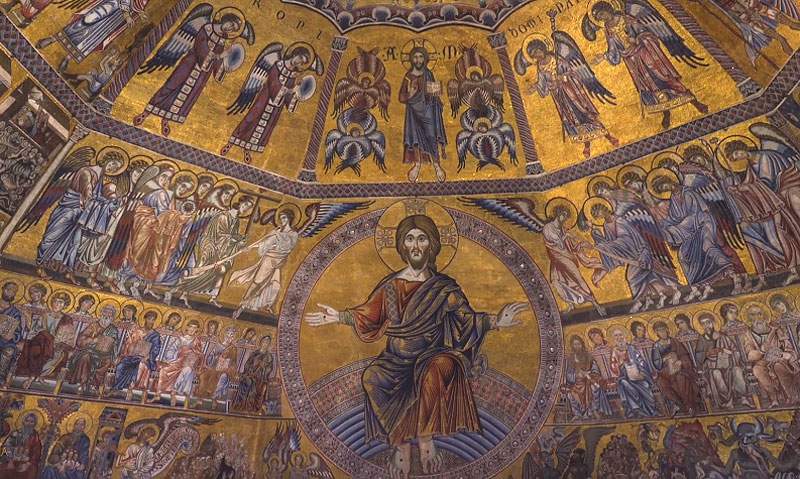Fourteenth-century mosaics of Florence Baptistery shine after restoration
The mosaics of the Florence Baptistery are shining again after three years of restoration: in fact, work has been completed on four of the eight interior sides of the Florentine Baptistery, and the restoration of the walls of the entire octagon is expected to be completed within the year. Meanwhile, on Monday, January 25, work will begin to dismantle the scaffolding used for the restored sides, the day when Florence Cathedral and Brunelleschi’s Dome will reopen to the public.
The major intervention involved more than 1,100 square meters of marble surfaces, more than 100 square meters of gilding and 200 square meters of mosaics depicting prophets, bishops and cherubic angels made by 14th-century Florentine masters. The restoration was entirely financed by theOpera di Santa Maria del Fiore, which “has invested more than one and a half million euros from 2017 to date,” said Vincenzo Vaccaro, adviser to the Opera di Santa Maria del Fiore, adding that “today’s project does not concern the restoration of the mosaics of the Dome, which will eventually be the subject of a subsequent restoration.”
After finishing the restoration of the exterior facades, the restoration of the interior walls covered in white marble, Prato green and mosaics began at the end of 2017: an intervention that proved to be very complex, affecting the architecture, structure and mosaic decoration. It was entrusted to the restorers of Impresa Cellini and Claudia Tedeschi, under the direction of the Opera di Santa Maria del Fiore, the high supervision of the ABAP Superintendency for the metropolitan city of Florence and the provinces of Pistoia and Prato, and the collaboration for diagnostic investigations with Italian universities and specialized laboratories.
From the campaign of studies and diagnostic investigations that have never before been carried out in such depth, many discoveries have emerged about the entire monument and its history: the mosaic technique used for the wall mosaics represents a unicum, as it is absolutely original; the presence of a pigmented wax on the Prato green used to cover the white of the limestone formed due to water infiltration from the roof, which was removed to bring back the natural color of the stone; the traces of gold leaf on one of the capitals of the women’s galleries, which may be evidence that they were all originally gilded, which combined with the gold background of the dome and wall mosaics, illuminated by candlelight, must have left anyone entering the Baptistery astonished.
The original idea of extending the mosaics completed on the Dome of the Baptistery to the walls, even though they were not originally planned, came between the first and second decades of the fourteenth century: it was necessary to find a way to superimpose the mosaics on the marble covering. Custom-made terracotta tiles were used,nicked and attached to the marble of the walls with central iron pins soldered to lead. “A sketchy sinopia was then made on the tiles and later the mosaic by the direct method and by giornate, identifiable and legible even today,” explained Beatrice Agostini, designer and director of restoration work for the Opera di Santa Maria del Fiore. “Even the mixture used to apply the mosaic tesserae is an absolute peculiarity, not a normal mortar but more a mastic was used, and it was precisely the degradation of this compound that represented the most complex problems faced by this restoration.”
“The experiences gained from previous restorations,” said Anna Maria Giusti, art historical consultant for the restoration, former director at the Opificio delle Pietre Dure, “carried out in past decades on the mosaics of the women’s galleries and on a part of the sides of the Baptistery, still not affected by the current intervention, represented a significant yardstick of comparison and showed a degradation that was decidedly less than that of the surfaces restored today.”
The work also included the cleaning of the Funeral Monument of Antipope John XXIII, a Renaissance sculptural work completed by Donatello and Michelozzo.
At this link the video
Ph.Credit Opera di Santa Maria del Fiore
 |
| Fourteenth-century mosaics of Florence Baptistery shine after restoration |
Warning: the translation into English of the original Italian article was created using automatic tools. We undertake to review all articles, but we do not guarantee the total absence of inaccuracies in the translation due to the program. You can find the original by clicking on the ITA button. If you find any mistake,please contact us.





























